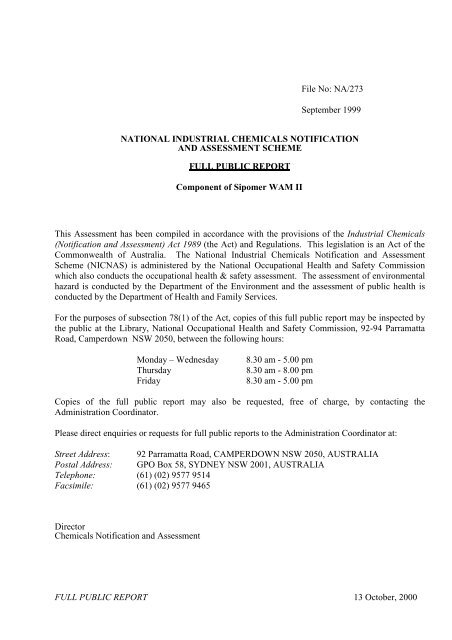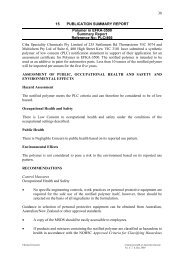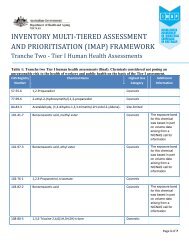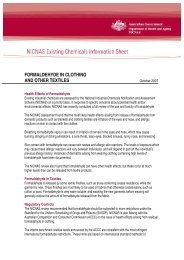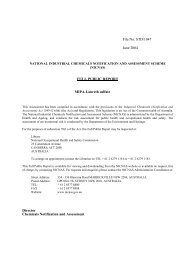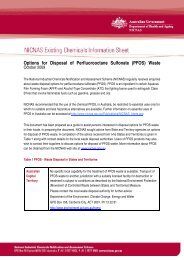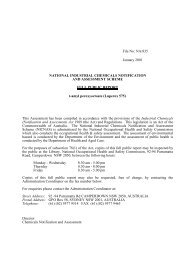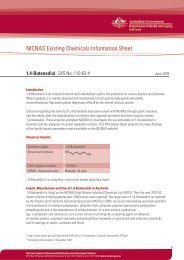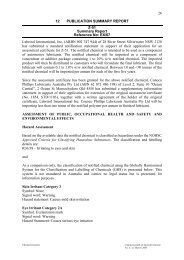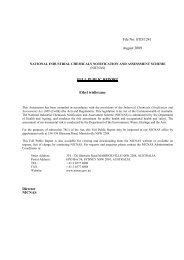Component of Sipomer WAM II - NICNAS
Component of Sipomer WAM II - NICNAS
Component of Sipomer WAM II - NICNAS
Create successful ePaper yourself
Turn your PDF publications into a flip-book with our unique Google optimized e-Paper software.
File No: NA/273<br />
September 1999<br />
NATIONAL INDUSTRIAL CHEMICALS NOTIFICATION<br />
AND ASSESSMENT SCHEME<br />
FULL PUBLIC REPORT<br />
<strong>Component</strong> <strong>of</strong> <strong>Sipomer</strong> <strong>WAM</strong> <strong>II</strong><br />
This Assessment has been compiled in accordance with the provisions <strong>of</strong> the Industrial Chemicals<br />
(Notification and Assessment) Act 1989 (the Act) and Regulations. This legislation is an Act <strong>of</strong> the<br />
Commonwealth <strong>of</strong> Australia. The National Industrial Chemicals Notification and Assessment<br />
Scheme (<strong>NICNAS</strong>) is administered by the National Occupational Health and Safety Commission<br />
which also conducts the occupational health & safety assessment. The assessment <strong>of</strong> environmental<br />
hazard is conducted by the Department <strong>of</strong> the Environment and the assessment <strong>of</strong> public health is<br />
conducted by the Department <strong>of</strong> Health and Family Services.<br />
For the purposes <strong>of</strong> subsection 78(1) <strong>of</strong> the Act, copies <strong>of</strong> this full public report may be inspected by<br />
the public at the Library, National Occupational Health and Safety Commission, 92-94 Parramatta<br />
Road, Camperdown NSW 2050, between the following hours:<br />
Monday – Wednesday 8.30 am - 5.00 pm<br />
Thursday 8.30 am - 8.00 pm<br />
Friday 8.30 am - 5.00 pm<br />
Copies <strong>of</strong> the full public report may also be requested, free <strong>of</strong> charge, by contacting the<br />
Administration Coordinator.<br />
Please direct enquiries or requests for full public reports to the Administration Coordinator at:<br />
Street Address: 92 Parramatta Road, CAMPERDOWN NSW 2050, AUSTRALIA<br />
Postal Address: GPO Box 58, SYDNEY NSW 2001, AUSTRALIA<br />
Telephone: (61) (02) 9577 9514<br />
Facsimile: (61) (02) 9577 9465<br />
Director<br />
Chemicals Notification and Assessment<br />
FULL PUBLIC REPORT 13 October, 2000
1. APPLICANT<br />
FULL PUBLIC REPORT<br />
<strong>Component</strong> <strong>of</strong> <strong>Sipomer</strong> <strong>WAM</strong> <strong>II</strong><br />
FULL PUBLIC REPORT 13/10/00<br />
NA/273 2/26<br />
NA/273<br />
Rhodia Australia Pty Ltd <strong>of</strong> 7 Citrus St BRAESIDE VIC 3195 has submitted a standard<br />
notification statement in support <strong>of</strong> their application for an assessment certificate for<br />
<strong>Component</strong> <strong>of</strong> <strong>Sipomer</strong> <strong>WAM</strong> <strong>II</strong> and has not applied for any information to be exempt from<br />
publication in the Full Public and Summary Reports.<br />
2. IDENTITY OF THE CHEMICAL<br />
Chemical Name: 1-methacrylamido, 2-imadazolidinone ethane<br />
Chemical Abstracts Service<br />
(CAS) Registry No.: 3089-19-8<br />
Other Names: methacrylamidoethylethylene urea; MAEEU<br />
Molecular Formula: C9H15N3O2<br />
Structural Formula:<br />
C<br />
H 3<br />
O<br />
H<br />
N<br />
N<br />
O<br />
NH
Molecular Weight: 197.2<br />
Method <strong>of</strong> Detection<br />
and Determination: infrared spectroscopy<br />
Spectral Data: an infrared spectrum was provided<br />
3. PHYSICAL AND CHEMICAL PROPERTIES<br />
The notified chemical is manufactured in a reaction which produces a mixture containing<br />
methacrylic acid (CAS No. 79-41-4) and is never isolated. Therefore, the following physicochemical<br />
properties are for the formulated product, <strong>Sipomer</strong> <strong>WAM</strong> <strong>II</strong>. Values calculated for<br />
the notified chemical using the ASTER program are given in parentheses.<br />
Appearance at 20°C<br />
and 101.3 kPa: amber liquid<br />
Boiling Point: 100°C (280°C*)<br />
Specific Gravity: 1 077 kg/m 3<br />
Vapour Pressure: < 0.013 kPa at 25°C (8.8 x 10 -5 kPa*)<br />
Water Solubility: not determined (8 840 g/L*)<br />
Partition Co-efficient<br />
(n-octanol/water): log Pow = -0.47 (-0.7*)<br />
Hydrolysis as a Function<br />
<strong>of</strong> pH: not determined (t½ = 190 days*)<br />
Adsorption/Desorption: not determined (log Koc = 0.956*)<br />
Dissociation Constant: not determined<br />
Flash Point: > 93°C<br />
Flammability Limits: not determined<br />
Autoignition Temperature: not determined<br />
Explosive Properties: not determined<br />
Reactivity/Stability: hazardous polymerisation may occur at temperatures<br />
above 90°C; incompatible with strong oxidising and<br />
reducing agents<br />
* calculated ASTER values for the notified chemical<br />
FULL PUBLIC REPORT 13/10/00<br />
NA/273 3/26
Comments on Physico-Chemical Properties<br />
The notified chemical was never isolated as a defined entity and the test data provided was<br />
for <strong>Sipomer</strong> <strong>WAM</strong> <strong>II</strong>, which is a 45% by weight aqueous solution <strong>of</strong> the product obtained<br />
from the following reaction:<br />
aminoethylethylene<br />
urea<br />
+<br />
2-methylacrylic<br />
anhydride<br />
→ MAEEU +<br />
2-methacrylic<br />
acid<br />
Water solubility data were not provided for the notified chemical but the notifier states that it<br />
is soluble in all proportions. The notifier also mentions a water solubility <strong>of</strong> 97g/L for the<br />
notified chemical in the Carp Oryzias latipes ecotoxicity report.<br />
Hydrolysis data were not provided, the notifier states that the notified chemical is a<br />
methacrylamide and should be stable in a wide pH range at 25°C.<br />
The boiling point <strong>of</strong> the notified substance was not available. The boiling point <strong>of</strong> the<br />
commercial product, <strong>Sipomer</strong> <strong>WAM</strong> <strong>II</strong> (45% aqueous solution) is reported to be 100°C.<br />
The partition coefficient, log POW, <strong>of</strong> <strong>Sipomer</strong> <strong>WAM</strong> <strong>II</strong> between n-octanol and water was<br />
calculated by Quantitative Structure Activity Relationship (QSAR) factors to be less than -<br />
0.47 at 20°C. The notifier has also supplied data for an analogue, the predecessor chemical,<br />
<strong>Sipomer</strong> <strong>WAM</strong> (see figure below). The partition coefficient, log POW, <strong>of</strong> <strong>Sipomer</strong> <strong>WAM</strong><br />
between n-octanol and water was estimated by the flask shaking method (OECD TG 107) to<br />
be < -1.4 at 20°C.<br />
O<br />
OH<br />
n = 1,2<br />
n<br />
H<br />
N<br />
<strong>Sipomer</strong> <strong>WAM</strong><br />
Adsorption and desorption data for the notified chemical was unavailable and the notifier has<br />
applied for a variation <strong>of</strong> schedule requirements based on the argument that all waste will be<br />
directed to trade waste treatment processes. Also, given that the notified chemical low<br />
partition coefficient (< -0.47) and contains nitrogen atom substituents, it would be expected<br />
to bind strongly to silicates in soils, but not to organic matter (Dragun, 1988).<br />
Dissociation data for the notified chemical was also unavailable and the notifier has applied<br />
for a variation <strong>of</strong> schedule requirements based on the argument that the chemical is not ionic.<br />
The notified chemical has no functional groups that would hydrolyse but at high pH the<br />
secondary nitrogen atoms may deprotonate.<br />
FULL PUBLIC REPORT 13/10/00<br />
NA/273 4/26<br />
N<br />
O<br />
NH
4. PURITY OF THE CHEMICAL<br />
The notified chemical is a component <strong>of</strong> the reaction mixture.<br />
Degree <strong>of</strong> Purity: 45.5%<br />
The composition <strong>of</strong> the mixture (hazardous and non hazardous impurities) is given below.<br />
Hazardous<br />
Impurities:<br />
Chemical Name CAS No. Weight %<br />
(range)<br />
Weight %<br />
(typical)<br />
Hazardous Properties<br />
methacrylic acid 79-41-4 20 – 25% 23% corrosive (R34) –<br />
concentration cut-<strong>of</strong>f 25%;<br />
at < 25% to 2%, irritant<br />
(R36/38) a ; exposure<br />
standard: 20 ppm TWA b<br />
methacrylic<br />
anhydride<br />
760-93-0 max. 2% poison by inhalation c<br />
hydroquinone 123-31-9 0.18 – 0.22% 0.2% harmful; concentration cut<strong>of</strong>f:<br />
25% d ; exposure<br />
standard: 2 mg/m 3 TWA b<br />
a NOHSC List <strong>of</strong> Designated Hazardous Substances; at 2% methacrylic acid to be classified<br />
with R36: irritating to eyes and R38: irritating to skin;<br />
b NOHSC Exposure Standards for Atmospheric Contaminants;<br />
c Sax NI & Lewis RJ (1996) Dangerous Properties <strong>of</strong> Industrial Materials. Van Nostrand<br />
Reinhold, New York. d NOHSC List <strong>of</strong> Designated Hazardous Substances; above 25%<br />
hydroquinone to be classified with R20/21/22: harmful by inhalation, in contact with skin or<br />
if swallowed;<br />
Non-hazardous Impurities<br />
(> 1% by weight):<br />
Chemical Name CAS No. Weight %<br />
(range)<br />
aminoethylethylene<br />
urea;<br />
6281-42-1<br />
water<br />
7732-18-5<br />
Additives/Adjuvants: none<br />
Weight %<br />
(typical)<br />
1 – 3 1.5<br />
FULL PUBLIC REPORT 13/10/00<br />
NA/273 5/26<br />
30
5. USE, VOLUME AND FORMULATION<br />
The notified chemical will not be manufactured in Australia. It will be imported into<br />
Australia in 200 L drums in the product <strong>Sipomer</strong> <strong>WAM</strong> <strong>II</strong> as a 45% solution. Import<br />
volumes for the notified chemical are as follows:<br />
Year 1 2 3 4 5<br />
Import volume (tonnes) 5 5 10 10 10<br />
<strong>Sipomer</strong> <strong>WAM</strong> <strong>II</strong> is intended for use as an additive in the surface coating industry,<br />
specifically as an adhesion promoter and binding agent for acrylic and vinyl-acrylic latex<br />
paints. No reformulation or repackaging <strong>of</strong> the notified chemical will be carried out in<br />
Australia. The acrylic latex paints will be available to the general public for decorative use.<br />
<strong>Sipomer</strong> <strong>WAM</strong> <strong>II</strong>, containing the notified chemical as a reactive monomer, is incorporated at<br />
~ 5% into monomer blends which are then reacted to form acrylic and vinyl-acrylic polymer<br />
latex emulsions. These emulsions are in turn used at ~ 50% in the formulation <strong>of</strong> acrylic and<br />
vinyl-acrylic paints. <strong>Sipomer</strong> <strong>WAM</strong> <strong>II</strong> is present in the formulated paints, as a reacted<br />
component <strong>of</strong> the latex polymer chain, at 0.5 to 1.0%, which equates to 0.25 to 0.5% <strong>of</strong> the<br />
notified chemical, MAEEU. This is equivalent to approximately 0.5 – 1% polymerised<br />
MAEEU in paint.<br />
6. OCCUPATIONAL EXPOSURE<br />
SIPOMER <strong>WAM</strong> <strong>II</strong> will be imported in 200 L steel drums and transported to customer sites<br />
to be used to manufacture latex emulsions. No repackaging will occur. Exposure <strong>of</strong><br />
transport and storage workers should only occur in the event <strong>of</strong> accidental spillage.<br />
At the customer sites, small samples will be taken for testing. The remainder in the drum will<br />
be pumped into a header tank by plant operators then the contents <strong>of</strong> the tank charged to a<br />
reaction vessel. Extractor fans remove vapours as the drums are discharged. The finished<br />
latex emulsion is pumped into 200 L drums in a closed system by the plant operators using an<br />
automated pumping mechanism. The header tank is rinsed with a water reflux and the<br />
washings pumped into the reaction tank. Any residual monomer is reacted to polymer with<br />
an added catalyst. The remaining monomer concentration is estimated to be several ppm.<br />
The reaction tank is rinsed to an effluent pit.<br />
Plant operators may be dermally exposed to drips and spills <strong>of</strong> the notified chemical during<br />
transfer <strong>of</strong> <strong>Sipomer</strong> <strong>WAM</strong> <strong>II</strong> to the reaction vessel. The notifier states that plant operators<br />
wear goggles, gloves, protective clothing and respirators if necessary.<br />
The notifier has indicated that exposure to the notified chemical may occur during product<br />
development, with up to 10 workers potentially exposed. This work would include the<br />
preparation <strong>of</strong> small batches <strong>of</strong> polymer and the evaluation <strong>of</strong> different paint formulations.<br />
Skin contamination may occur during these operations. The protective equipment to be worn<br />
by product development personnel was not specified in the notification, but it would be<br />
FULL PUBLIC REPORT 13/10/00<br />
NA/273 6/26
expected to be similar to that worn by plant operators.<br />
The notified chemical is at 2.5% in the latex emulsion polymers. As it is now part <strong>of</strong> a<br />
polymer chain further exposure <strong>of</strong> workers should be minimal.<br />
The customers are identified as major paint manufacturers who will reformulate the latex<br />
emulsions into decorative paints. These paints are typically manufactured in closed systems<br />
and local exhaust ventilation is used to remove solvent vapours. Paints are typically filled<br />
into 1 L – 200 L containers in closed systems and transported to customers.<br />
The notifier has not specifically stated how the paints will be applied but it can be expected<br />
that brush, roller and spray methods may be used. During these operations, exposure to<br />
workers should be minimal.<br />
7. PUBLIC EXPOSURE<br />
Public exposure to the notified chemical will occur during do-it-yourself (DIY) painting<br />
projects. The extent <strong>of</strong> the exposure will depend on the size <strong>of</strong> the project and the number <strong>of</strong><br />
persons exposed will be determined by the commercial success <strong>of</strong> the products containing<br />
the notified chemical. As <strong>Sipomer</strong> <strong>WAM</strong> <strong>II</strong> is chemically incorporated into the structure <strong>of</strong><br />
the polymer latex component <strong>of</strong> the paint prior to sale to the public, exposure to the notified<br />
chemical itself is likely to be negligible. Once dry, the notified chemical will be bound into<br />
the matrix <strong>of</strong> the paint and exposure resulting from contact with painted surfaces will again<br />
be negligible. Similarly, exposure resulting from the inhalation <strong>of</strong> paint particles generated<br />
during the sanding <strong>of</strong>f <strong>of</strong> surfaces previously painted with paints containing the notified<br />
chemical will be negligible, as the bioavailability <strong>of</strong> the compound from the cured paint<br />
particles is likely to be low to negligible.<br />
In the event <strong>of</strong> a transport accident involving containers <strong>of</strong> paint containing the notified<br />
chemical, the public is unlikely to come into contact with it as it will be bound into the<br />
polymer latex <strong>of</strong> the paint (see below). Spilt paint may be recovered by adsorption onto<br />
suitable material such as sand with subsequent disposal in accordance with local government<br />
regulations. If a transport accident were to involve drums <strong>of</strong> <strong>Sipomer</strong> <strong>WAM</strong> <strong>II</strong> the potential<br />
for exposure would be increased. The notified chemical is highly water soluble and would<br />
readily enter water ways. Precautions against dispersion <strong>of</strong> spilt material following a<br />
transport accident should be taken. As the material is not volatile, little hazard would be<br />
presented to the public in the vicinity <strong>of</strong> the accident unless direct contact with the material<br />
occurred.<br />
The manufacture <strong>of</strong> paints containing the notified chemical is not anticipated to lead to direct<br />
public exposure. The notified chemical has a low vapour pressure and normal industrial<br />
hygiene practices would be anticipated to constrain uncontrolled loss <strong>of</strong> the liquid into the<br />
environment surrounding the manufacturing premises.<br />
FULL PUBLIC REPORT 13/10/00<br />
NA/273 7/26
8. ENVIRONMENTAL EXPOSURE<br />
Release<br />
There is potential for release <strong>of</strong> the notified chemical during the latex polymer manufacture,<br />
paint formulation and paint application. Manufacture and formulation processes will take<br />
place at paint manufacturing companies across Australia and any spills that occur are<br />
assumed to be contained by plant bunding.<br />
During the manufacture and formulation processes, up to 1% <strong>of</strong> latex paint would be lost due<br />
to spills and washing <strong>of</strong> equipment according to notifier estimates. This equates to a loss <strong>of</strong><br />
100 kg per year <strong>of</strong> the notified chemical. During painting application the notifier expects that<br />
0.5% latex paint waste (50 kg <strong>of</strong> MAEEU annually) will be produced from the washing <strong>of</strong><br />
equipment.<br />
The notifier estimates that transport drums emptied at the formulation site will contain<br />
<strong>Sipomer</strong> <strong>WAM</strong> <strong>II</strong> residues at no more than 0.5%, 50 kg <strong>of</strong> the notified chemical per annum.<br />
The drums will be thoroughly rinsed with water and sent to drum reconditioners.<br />
Some residue will also remain in the ‘empty’ paint containers after use. It is estimated that<br />
200 kg <strong>of</strong> the notified chemical (2% <strong>of</strong> the container contents) will remain as residue in the<br />
containers annually. However, if significant quantities <strong>of</strong> the paints are used in the DIY<br />
market, a higher figure is expected.<br />
Fate<br />
The waste generated in manufacture, formulation and application <strong>of</strong> the coating will be<br />
disposed to landfill, or by incineration. At the manufacturing and formulation site the<br />
notified chemical will be recovered as part <strong>of</strong> an insoluble solid from wastewater and<br />
disposed <strong>of</strong> to landfill. The containers and their residue will also be disposed <strong>of</strong> to landfill.<br />
Leaching <strong>of</strong> the notified chemical from landfill is unlikely, given the expected low solubility<br />
<strong>of</strong> the notified chemical once bound inside the polymer matrix <strong>of</strong> the latex paint.<br />
Once applied to the surfaces <strong>of</strong> houses as paint, the notified chemical will be incorporated in<br />
a hard, durable, inert film where it will be immobilised and would not present a significant<br />
hazard. Any fragments, chips and flakes <strong>of</strong> the paint will be inert and <strong>of</strong> little concern.<br />
Eventually the surfaces that are coated with the latex paint containing the notified chemical<br />
will enter the waste disposal stream for either recycling or ultimately for disposal as waste in<br />
landfill. Once in the landfill sites, movement <strong>of</strong> the chemical by leaching is not expected<br />
because it will be locked within the polymer matrix <strong>of</strong> the latex paint.<br />
Any <strong>of</strong> the latex polymer paint containing the notified chemical released to the sewer, for<br />
example, via washing <strong>of</strong> paint application equipment for example, would be insoluble, and<br />
expected to become associated with the sewerage plant sludge. The sludge would be either<br />
deposited into landfill or incinerated.<br />
The cross-linked matrix is not expected to cross biological membranes, due to its expected<br />
low solubility and high molecular weight and as such should not bioaccumulate<br />
(Connell, 1989).<br />
FULL PUBLIC REPORT 13/10/00<br />
NA/273 8/26
The inherent biodegradability <strong>of</strong> the notified chemical was tested by the modified Semi<br />
Continuous Activated Sludge test (EPA: 796.3340) over a period <strong>of</strong> 7 weeks. While this test<br />
employs synthetic sewage and is not necessarily an accurate model <strong>of</strong> a sewage treatment<br />
plant, the notifier claims that it is a useful method for assessing inherent biodegradability.<br />
Within a 7 week exposure period to micro-organisms, the notified chemical was degraded by<br />
59%.<br />
A 64 day aerobic soil biodegradation study (EPA: 769.3400) was also conducted on the<br />
notified chemical at 22°C, with Boone County (USA) silt loam soil (Alfisal). After 64 days<br />
the notified chemical was degraded by 95%.<br />
9. EVALUATION OF TOXICOLOGICAL DATA<br />
Toxicological data were available for <strong>Sipomer</strong> <strong>WAM</strong> <strong>II</strong> (45.5% notified chemical, 23%<br />
methacrylic acid, up to 2% methacrylic anhydride, 1.5% aminoethylethylene urea and 0.2%<br />
hydroquinone) and <strong>Sipomer</strong> <strong>WAM</strong> (an analogue <strong>of</strong> the notified chemical – see Section 3 for<br />
structure).<br />
9.1 Acute Toxicity<br />
Summary <strong>of</strong> the acute toxicity <strong>of</strong> <strong>Sipomer</strong> <strong>WAM</strong> <strong>II</strong><br />
Test Species Outcome Reference<br />
acute oral toxicity rat LD50 > 5 000 mg/kg (Tox Monitor<br />
Laboratories<br />
Inc, 1989)<br />
skin irritation rabbit slight to moderate<br />
irritant<br />
eye irritation rabbit moderate to severe<br />
irritant<br />
(Tox Monitor<br />
Laboratories<br />
Inc, 1989)<br />
(Tox Monitor<br />
Laboratories<br />
Inc, 1989)<br />
FULL PUBLIC REPORT 13/10/00<br />
NA/273 9/26
Summary <strong>of</strong> the acute toxicity <strong>of</strong> <strong>Sipomer</strong> <strong>WAM</strong><br />
Test Species Outcome Reference<br />
acute oral toxicity rat LD50 > 5 000 mg/kg (Verlangieri &<br />
Shapiro, 1980a;<br />
Verlangieri &<br />
Shapiro, 1980b)<br />
skin irritation rabbit inconclusive (Verlangieri &<br />
Shapiro, 1980c<br />
and 1980e)<br />
eye irritation rabbit moderate irritant (Verlangieri &<br />
Shapiro, 1980d)<br />
skin irritation Guinea pig non sensitiser (Spear, 1985)<br />
9.1.1 Oral Toxicity<br />
9.1.1.1 <strong>Sipomer</strong> <strong>WAM</strong> <strong>II</strong> (Tox Monitor Laboratories Inc, 1989)<br />
Only a summary <strong>of</strong> a toxicological study was provided. The study was conducted on albino<br />
rats (5/sex) and the LD50 was reported to be greater than 5 000 mg/kg. Three females died<br />
within 48 hours <strong>of</strong> dosing. It was stated that animals appeared sickly following dosing.<br />
Organs <strong>of</strong> the thorax and abdomen appeared normal in the survivors.<br />
9.1.1.2 <strong>Sipomer</strong> <strong>WAM</strong> (Verlangieri & Shapiro, 1980a; Verlangieri & Shapiro, 1980b)<br />
Two studies were provided but the brief reporting <strong>of</strong> the methodology renders their validity<br />
uncertain. However, the conclusions were that in Wistar rats, the acute oral (gavage) LD50<br />
was 4.6 mL/kg for a 50% aqueous solution <strong>of</strong> the test substance and greater than 5.0 mL/kg<br />
for an 80% solution.<br />
9.1.2 Dermal Toxicity<br />
No data provided.<br />
9.1.3 Inhalation Toxicity<br />
No data provided.<br />
FULL PUBLIC REPORT 13/10/00<br />
NA/273 10/26
9.1.4 Skin Irritation<br />
9.1.4.1 <strong>Sipomer</strong> <strong>WAM</strong> <strong>II</strong> (Tox Monitor Laboratories Inc, 1989)<br />
Species/strain: rabbit/New Zealand White<br />
Number/sex <strong>of</strong> animals: 3/unspecified<br />
Observation period: 72 hours<br />
Method <strong>of</strong> administration: 0.5 mL <strong>of</strong> the test substance was placed on the skin<br />
under occlusive dressing for 24 hours<br />
Draize scores (Draize, 1959):<br />
Time after<br />
treatment<br />
(days)<br />
Erythema<br />
1 3<br />
1 1 a<br />
0<br />
2 2 0<br />
3 2 0<br />
Oedema<br />
1 1 0<br />
2 2 0<br />
3 2 0<br />
a<br />
see Attachment 1 for Draize scales<br />
Test method: similar to OECD guidelines<br />
Result: the notified chemical was a slight to moderate skin<br />
irritant in rabbits<br />
9.1.4.2 <strong>Sipomer</strong> <strong>WAM</strong><br />
Skin corrosion test (Verlangieri & Shapiro, 1980c)<br />
<strong>Sipomer</strong> <strong>WAM</strong> was scored for skin corrosion (tissue destruction) in six New Zealand White<br />
rabbits. One half mL <strong>of</strong> the test substance was administered under occlusive dressing for 4<br />
hours. After dressing removal, skin corrosion was scored at 4 and 48 hours. No skin<br />
corrosion was noted.<br />
Skin irritation test (Verlangieri & Shapiro, 1980e)<br />
A summary <strong>of</strong> a skin irritation test in rabbits was provided but the data were poorly reported.<br />
FULL PUBLIC REPORT 13/10/00<br />
NA/273 11/26
9.1.5 Eye Irritation<br />
9.1.5.1 <strong>Sipomer</strong> <strong>WAM</strong> <strong>II</strong> (Tox Monitor Laboratories Inc, 1989)<br />
Species/strain: rabbit/New Zealand White<br />
Number/sex <strong>of</strong> animals: 3/unspecified<br />
Observation period: 14 days<br />
Method <strong>of</strong> administration: 0.1 mL <strong>of</strong> the test substance into one eye<br />
Draize scores (Draize, 1959) <strong>of</strong> unirrigated eyes:<br />
Time after instillation<br />
Animal 1 day 2 days 3 days 7 days 14 days<br />
Cornea o a o a o a o a o a<br />
1 1 1<br />
3 1 3 1 2 2 2 2 2<br />
2 2 4 2 4 2 4 2 4 2 4<br />
3 2 4 2 4 2 4 2 4 2 4<br />
Iris<br />
1 1 1 0 0 0<br />
2 1 1 1 2 2<br />
3 1 1 1 1 1<br />
Conjunctiva r c d r c d r c d r c d r c d<br />
1 2 2 3 2 2 2 2 2 2 2 1 1 1 0 1<br />
2 2 3 3 2 3 3 2 3 3 2 2 3 2 2 3<br />
3 2 3 3 2 3 3 2 3 3 2 1 2 2 1 1<br />
1<br />
see Attachment 1 for Draize scales<br />
o = opacity a = area r = redness c = chemosis d =<br />
discharge<br />
Test method: similar to OECD guidelines<br />
Result: the notified chemical was a moderate to severe eye<br />
irritant in rabbits<br />
9.1.5.2 <strong>Sipomer</strong> <strong>WAM</strong> (Verlangieri & Shapiro, 1980d)<br />
Species/strain: rabbit/New Zealand White<br />
Number/sex <strong>of</strong> animals: 6/unspecified<br />
Observation period: 7 days<br />
FULL PUBLIC REPORT 13/10/00<br />
NA/273 12/26
Method <strong>of</strong> administration: 0.1 mL <strong>of</strong> the test substance into one eye<br />
FULL PUBLIC REPORT 13/10/00<br />
NA/273 13/26
Draize scores (Draize, 1959) <strong>of</strong> unirrigated eyes:<br />
Draize scores were zero at beyond 4 days post-instillation. Scores at 24, 48 and 72<br />
hours were as follows:<br />
Time after instillation<br />
Animal 1 day 2 days 3 days<br />
Cornea o a o a o a<br />
1 1 1<br />
4 1 4 0 0<br />
2 - 6<br />
Iris<br />
0 0 0 0 0 0<br />
1 - 6 0 0 0<br />
Conjunctiva r c d r c d r c d<br />
1 2 1 2 0 0 0 0 0 0<br />
2 2 0 0 0 0 0 0 0 0<br />
3 2 0 0 1 0 0 0 0 0<br />
4 2 2 2 2 2 0 0 0 1<br />
5 1 0 3 1 0 2 0 0 0<br />
6 3 3 3 2 2 2 0 0 0<br />
1<br />
see Attachment 1 for Draize scales<br />
o = opacity a = area r = redness c = chemosis d =<br />
discharge<br />
Test method: similar to OECD guidelines<br />
Result: the notified chemical was a moderate eye irritant in<br />
rabbits although severe irritation was observed in<br />
one rabbit at 24 hours post-instillation<br />
9.1.6 Skin Sensitisation (Spear & Shapiro, 1985)<br />
Data were not provided for <strong>Sipomer</strong> <strong>WAM</strong> <strong>II</strong>. The following data are for <strong>Sipomer</strong> <strong>WAM</strong>.<br />
Species/strain: guinea pig/Dunkin-Hartley<br />
Number <strong>of</strong> animals: 10 males in test group; 10 males treated with positive<br />
control substance dinitrochlorobenzene (0.3%)<br />
Induction procedure:<br />
test group:<br />
day 1 and alternate days<br />
excluding weekends for 10<br />
applications<br />
0.5 mL test substance applied to the thoracolumbar<br />
region under semi-occlusive dressing for 6 hours<br />
FULL PUBLIC REPORT 13/10/00<br />
NA/273 14/26
control group:<br />
0.3% DNCB as above as above<br />
Challenge procedure:<br />
14 days after 10 th induction<br />
application<br />
application as for induction to the left flank<br />
Test method: Buehler method, OECD TG 406<br />
Challenge outcome:<br />
Test animals Positive control animals<br />
Challenge<br />
concentration 24 hours* 48 hours* 24 hours* 48 hours*<br />
100% 0/10** 0/10 9/9 9/9<br />
* time after patch removal<br />
** number <strong>of</strong> animals exhibiting positive response<br />
Result: the notified chemical was not sensitising to the skin <strong>of</strong><br />
guinea pigs<br />
9.2 Repeated Dose Toxicity (<strong>Sipomer</strong> <strong>WAM</strong> <strong>II</strong>)<br />
For this study, only the results tables were available.<br />
Species/strain: rat/unspecified<br />
Number/sex <strong>of</strong> animals: 6/sex/dose group<br />
Method <strong>of</strong> administration: oral, assumed to be by gavage<br />
Dose/Study duration: 0, 40, 200 or 1 000 mg/kg/day with extra 14-day<br />
recovery groups for the control and high dose<br />
Clinical observations: body weight and food consumption were<br />
unaffected by treatment<br />
Clinical<br />
chemistry/Haematology/<br />
Urinalysis<br />
2 high dose males and 1 high dose female<br />
(recovery group) died during the study<br />
the most significant observations were salivation<br />
and abnormal respiratory sound in the high dose<br />
group and recovery group<br />
Haematology<br />
no treatment-related effects<br />
Clinical Chemistry<br />
FULL PUBLIC REPORT 13/10/00<br />
NA/273 15/26
serum glucose was 18% lower in the female high<br />
dose recovery group; females <strong>of</strong> the high dose<br />
group exhibited a 2% drop in chloride relative to<br />
controls<br />
Urinalysis<br />
the female high dose recovery group exhibited a<br />
doubling <strong>of</strong> the urine volume<br />
Macroscopic findings: Organ weights<br />
the female high dose group exhibited a 13%<br />
increase in relative kidney weight in comparison<br />
with controls<br />
Gross pathological findings<br />
elevation <strong>of</strong> the mucosa <strong>of</strong> the forestomach was<br />
found in 3 high dose males and 6 high dose<br />
females; in the two males found dead, the small<br />
intestine and stomach (one animal) and large<br />
intestine (the other animal) were filled with gas;<br />
the female found dead had a gas-filled stomach<br />
Histopathology: 4 males and 6 females <strong>of</strong> the high dose group<br />
exhibited hyperkeratosis <strong>of</strong> the forestomach; in one<br />
high dose male a whitish region <strong>of</strong> the left testis<br />
correlated with decreased spermatogenesis and<br />
sperm granuloma; in this same male increased<br />
eosinophilic bodies were observed in the kidney;<br />
the two males and female found dead had lung<br />
congestion and one <strong>of</strong> the males had spleen<br />
atrophy; in both male and female recovery groups,<br />
no abnormalities were detected<br />
Test method: similar to OECD guidelines<br />
Result: the notified chemical had local effects on the<br />
forestomach with a NOEL <strong>of</strong> 200 mg/kg/day<br />
9.3 Genotoxicity<br />
9.3.1 Salmonella typhimurium and Escherichia coli Reverse Mutation Assay<br />
9.3.1.1 <strong>Sipomer</strong> <strong>WAM</strong> <strong>II</strong> (Eda, 1993)<br />
Strains: S. typhimurium strains TA 98, TA 100, TA 1535,<br />
TA 1537; E. coli strain WP2 uvrA<br />
Concentration range: 0, 50, 100, 200, 500, 1 000, 2 000 or 5 000 µg/plate<br />
(experiment 1); 0, 313, 625, 1 250, 2 500 or<br />
5 000 µg/plate (experiment 2)<br />
FULL PUBLIC REPORT 13/10/00<br />
NA/273 16/26
Test method: similar to OECD guidelines<br />
Comment: negative controls were within acceptable limits and<br />
the positive controls demonstrated the sensitivity <strong>of</strong><br />
the test; there was no mention <strong>of</strong> cytotoxicity <strong>of</strong> the<br />
test substance<br />
Result: the test substance did not induce an increased<br />
number <strong>of</strong> mutants above background in either the<br />
absence or presence <strong>of</strong> metabolic activation<br />
provided by rat liver S9 mix<br />
9.3.1.2 <strong>Sipomer</strong> <strong>WAM</strong> (Wolf & Shapiro, 1985)<br />
Strains: S. typhimurium strains TA 98, TA 100, TA 1535,<br />
TA 1537 and TA 1538<br />
Concentration range: 0, 0.5, 1, 5, 10 or 50 µL/plate<br />
Test method: similar to OECD guidelines<br />
Comment: negative controls were within acceptable limits and<br />
the positive controls demonstrated the sensitivity <strong>of</strong><br />
the test; cytotoxicity was observed at 100 µL/plate<br />
Result: the test substance did not induce an increased<br />
number <strong>of</strong> mutants above background in either the<br />
absence or presence <strong>of</strong> metabolic activation<br />
provided by rat liver S9 mix<br />
9.3.2 Chromosomal Aberrations in Chinese Hamster Lung (CHL) Cells: <strong>Sipomer</strong><br />
<strong>WAM</strong> <strong>II</strong> (Ajimi, 1993)<br />
Cell line: CHL<br />
Doses: 0, 300, 450 or 600 µg/mL (absence <strong>of</strong> metabolic<br />
activation provided by rat liver S9 mix); 0, 500, 1<br />
000 or 2 000 µg/mL (absence and presence <strong>of</strong> S9<br />
mix); treatment times were 24 and 48 hours<br />
Test method: similar to OECD guidelines<br />
Comment: a cell fission suppression test established an upper<br />
dose limit <strong>of</strong> 600 µg/mL in the absence <strong>of</strong> S9 and<br />
2 000 µg/mL in the presence <strong>of</strong> S9; the percentage<br />
<strong>of</strong> cells containing chromosomal aberrations (CA)<br />
(excluding gaps) observed in this study was<br />
maximal at the highest doses as follows:<br />
FULL PUBLIC REPORT 13/10/00<br />
NA/273 17/26
treatment dose % cells with<br />
time (hr) (µµµµg/mL) CA<br />
- S9<br />
24 h 0 0.5 (1.0*)<br />
600 21.0<br />
2 000 32.5<br />
48 h 0 0.0<br />
600 45.5<br />
+S9<br />
24 h 0 1.0<br />
2 000 2.5<br />
* control for study ±S9 with a top dose <strong>of</strong> 2 000<br />
µg/mL<br />
Result: the test substance was clastogenic in CHL cells in<br />
the absence <strong>of</strong> S9 fraction<br />
9.4 Neurotoxicity, Developmental Toxicity and Genetic Toxicity <strong>of</strong> Acrylamide and<br />
Analogues<br />
There are a number <strong>of</strong> studies in the peer-reviewed literature concerning the neurotoxicity,<br />
developmental toxicity and genetic toxicity <strong>of</strong> acrylamide and structural analogue chemicals.<br />
There are also a number <strong>of</strong> other studies uncovered by literature search but these are not<br />
reviewed here as they have not been peer-reviewed and only the abstract was available.<br />
Chapin et al. (1995) summarised the literature on acrylamide toxicity and that <strong>of</strong> various<br />
analogues as a preamble to a multigeneration study <strong>of</strong> the effects <strong>of</strong> acrylamide, N, N’methylenebisacrylamide,<br />
N-(hydroxymethyl)acrylamide and methacrylamide on Swiss mice.<br />
Acrylamide acts at several levels in the reproductive system: alteration <strong>of</strong> mating and<br />
copulatory behaviour, damage <strong>of</strong> testicular structure and effects on epididymal sperm<br />
function. The ability to cause dominant lethality in epididymal sperm, heritable<br />
translocations in testicular germ cells and other genetic damage suggests a genetic effect. A<br />
study by Hashimoto and co-workers (cited by Chapin et al., 1995) the ability <strong>of</strong> acrylamide<br />
and analogues to produce neurotoxicity and testicular atrophy. The testicular effects and<br />
neurotoxicity <strong>of</strong> acrylamide and related compounds administered at ½ or 1 /3 <strong>of</strong> the LD50<br />
demonstrated that the testicular effects and neurotoxicity were not strongly related. In terms<br />
<strong>of</strong> neurotoxicity (a single test <strong>of</strong> ability to decrease time or a rotorod) the compounds were<br />
ranked (from the most potent to the least potent) as isopropyl acrylamide > acrylamide ><br />
methacrylamide > N-(hydroxymethyl)-acrylamide > N, N’-methylenebisacrylamide. Based<br />
on decreased terminal testis weight, the compounds were ranked (from the most potent to the<br />
least potent) as N, N’-methylenebisacrylamide > N-(hydroxymethyl)-acrylamide > isopropyl<br />
acrylamide > acrylamide > methacrylamide. However, Chapin et al. (1995) suggest that<br />
testicular weight is a gross measure <strong>of</strong> reproductive toxicity. In their study with Swiss mice,<br />
doses were kept low to minimise structural testicular damage, thereby allowing a comparison<br />
<strong>of</strong> the relative sensitivity <strong>of</strong> neurotoxicity and dominant lethality.<br />
FULL PUBLIC REPORT 13/10/00<br />
NA/273 18/26
Chapin et al. (1995) concluded that the primary site <strong>of</strong> reproductive toxicity <strong>of</strong> acrylamide<br />
was in the male and that it was entirely accounted for by dominant lethal activity. A lack <strong>of</strong><br />
female reproductive toxicity was consistent with other reports. There was greater detectable<br />
reproductive toxicity than neurotoxicity, particularly in the second generation. Reproductive<br />
toxicity in the form <strong>of</strong> dominant lethality was also observed for N, N’methylenebisacrylamide<br />
and N-(hydroxymethyl)-acrylamide with minimal neurotoxicity<br />
observed at low doses used in these studies. On a constant dose basis the ranking was N, N’methylenebisacrylamide<br />
> acrylamide > N-(hydroxymethyl-acrylamide. No effects were<br />
seen with methacrylamide at the doses used.<br />
An earlier review <strong>of</strong> the health effects <strong>of</strong> acrylamide was published by the International<br />
Programme on Chemical Safety (Anon, 1985). In humans acrylamide poisoning can be<br />
associated with peripheral neuropathy and autonomic nervous system involvement. Although<br />
acrylamide was not mutagenic in Salmonella typhimurium, it induced chromosomal<br />
aberrations in the spermatocytes <strong>of</strong> male mice and increased the cell transformation<br />
frequency in Balb 3T3 cells in the presence <strong>of</strong> a metabolic activation system. Acrylamide<br />
was shown to be an initiator for skin tumours in mice when administered by various routes<br />
and increased the incidence <strong>of</strong> lung tumours in mice screening assays. There is no evidence<br />
in either man or animals <strong>of</strong> any gross teratogenic effects resulting from acrylamide exposure.<br />
A literature review provided by the notifier comprised various abstracts <strong>of</strong> studies on the<br />
biological effects <strong>of</strong> methacrylamide. A study by the National Toxicology Program (George,<br />
1991), in which CD-1 mice were administered methacrylamide via the oral route on gestation<br />
days 6 - 17 at dose levels up to 180 mg/kg, revealed mild maternal effects at the top dose.<br />
Clear developmental toxicity was observed namely an increased proportion <strong>of</strong> non-live<br />
implants and decreased mean foetal body weight per litter.<br />
The notifier provided a structure-activity analysis <strong>of</strong> the notified chemical and other<br />
acrylamide analogues. It was argued that the notified chemical contains a bulky substituent<br />
on the amide nitrogen and that this would reduce the biological activity, as evidenced by the<br />
fact that the LD50 <strong>of</strong> N-substituted acrylamide analogues is inversely proportional to the size<br />
<strong>of</strong> the substituent. It was also argued that 2-methyl substitution at the double bond (such as<br />
occurs in the notified chemical) reduces the biological activity. Evidence for this is that the<br />
neurotoxicity <strong>of</strong> methacrylamide is about 10-fold lower than for acrylamide. Although this<br />
may be the case, the IPCS review suggests that acrylamide analogues can undergo<br />
biotransformation to acrylamide in vivo and that this could be a possible cause for their<br />
biological activity.<br />
9.5 Overall Assessment <strong>of</strong> Toxicological Data<br />
There were no toxicological data for the notified chemical itself. However, there were data<br />
available for the product to be imported: <strong>Sipomer</strong> <strong>WAM</strong> <strong>II</strong> and for an analogue, <strong>Sipomer</strong><br />
<strong>WAM</strong>.<br />
<strong>Sipomer</strong> <strong>WAM</strong> <strong>II</strong> and <strong>Sipomer</strong> <strong>WAM</strong> exhibited very low acute oral toxicity in rats (LD50 ><br />
5 000 mg/kg). <strong>Sipomer</strong> <strong>WAM</strong> <strong>II</strong> was a slight to moderate skin irritant in rabbits and the<br />
<strong>Sipomer</strong> <strong>WAM</strong> data were inconclusive. <strong>Sipomer</strong> <strong>WAM</strong> <strong>II</strong> was a moderate to severe eye<br />
irritants in rabbits, possibly due to the methacrylic acid component and <strong>Sipomer</strong> <strong>WAM</strong> was<br />
a moderate eye irritant. It would be classified for health effects as an eye irritant, under the<br />
FULL PUBLIC REPORT 13/10/00<br />
NA/273 19/26
NOHSC Approved Criteria for Classifying Hazardous Substances (National Occupational<br />
Health and Safety Commission, 1999a).<br />
The eye irritation <strong>of</strong> <strong>Sipomer</strong> <strong>WAM</strong> <strong>II</strong> may have been contributed to by the methacrylic<br />
acid, which is corrosive.<br />
<strong>Sipomer</strong> <strong>WAM</strong> was not a skin sensitiser in guinea pigs. Both chemicals were not mutagenic<br />
in bacteria but <strong>Sipomer</strong> <strong>WAM</strong> <strong>II</strong> was clastogenic in CHL cells.<br />
In a 28-day repeated dose oral study in rats, the main effects <strong>of</strong> <strong>Sipomer</strong> <strong>WAM</strong> <strong>II</strong> were local<br />
effects on the forestomach with a NOEL <strong>of</strong> 200 mg/kg/day.<br />
The notified chemical is an analogue <strong>of</strong> acrylamide, which is a known genetic, reproductive<br />
and neural toxicant. It is listed in the NOHSC List <strong>of</strong> Designated Hazardous Substances<br />
(National Occupational Health and Safety Commission, 1999b) as a category 2 carcinogen<br />
and a category 2 mutagen. The risk phrases R45: May cause cancer; R46: May cause<br />
heritable genetic damage and R 48/23/24/25: Toxic: danger <strong>of</strong> serious damage to health by<br />
prolonged exposure through inhalation, in contact with skin and if swallowed are<br />
appropriate for acrylamide.<br />
A closer analogue <strong>of</strong> the notified chemical is methacrylamide, which also has 2-methyl<br />
substitution at the double bond. From analogue data, methacrylamide appears to be less<br />
toxic than acrylamide. It is not listed on the NOHSC Designated List <strong>of</strong> Hazardous<br />
Substances (National Occupational Health and Safety Commission, 1999b) but exhibits<br />
neurotoxicity and developmental toxicity, namely increased resorptions. As<br />
methacrylamide does not have the bulky substituent on the amide nitrogen, it is believed to<br />
be more reactive than the notified chemical.<br />
Therefore based on test data for <strong>Sipomer</strong> <strong>WAM</strong> <strong>II</strong> and analogue data for <strong>Sipomer</strong> <strong>WAM</strong> and<br />
the acrylamides, the notified chemical would be expected to have low acute toxicity, slight<br />
to moderate skin irritant properties and moderate eye irritant properties. It would not be<br />
expected to be a skin sensitiser. On the test data available, the genotoxicity pr<strong>of</strong>ile is<br />
inconclusive.<br />
Based on analogue data, the notified chemical may have reproductive and neurotoxicity<br />
properties, however, on the assumption that the chemical would be less reactive than<br />
methacrylamide, hazard classification on the basis <strong>of</strong> these properties cannot be justified.<br />
The available data supports a hazardous substance health effects classification <strong>of</strong> the notified<br />
chemical as an eye irritant, with the risk phrase R36.<br />
<strong>Sipomer</strong> <strong>WAM</strong> <strong>II</strong>, containing the notified chemical and methacrylic acid, is a hazardous<br />
substance with the risk phrases R36/38, based on test data and the concentration <strong>of</strong> free<br />
methacrylic acid.<br />
FULL PUBLIC REPORT 13/10/00<br />
NA/273 20/26
10. ASSESSMENT OF ENVIRONMENTAL EFFECTS<br />
The notifier has supplied the following ecotoxicity studies summarised below.<br />
Test Species Test concentrations<br />
(nominal) mg/L<br />
Acute Toxicity<br />
(Semi-Static Test)<br />
(OECD TG 203)<br />
Carp<br />
Oryzias latipes<br />
9, 13, 20, 30, 44, 67<br />
& 100<br />
Acute Toxicity -<br />
Immobilisation<br />
(Static Test)<br />
(OECD TG 202)<br />
Water Flea<br />
(Daphnia magna)<br />
*This test and result is for <strong>Sipomer</strong> <strong>WAM</strong><br />
168, 240, 343, 490,<br />
700 & 1000<br />
Results (nominal)<br />
mg/L<br />
48 h LC50 = 22.6<br />
24 h EC50 > 1000*<br />
Fish<br />
A 48-hour definitive study, performed in accordance with OECD test guidelines,<br />
demonstrated that <strong>Sipomer</strong> <strong>WAM</strong> <strong>II</strong> had no toxic effects on the test fish up to a nominal<br />
concentration <strong>of</strong> 13 mg/L. A 48 h LC50 was estimated to be 22.6 mg/L using the method <strong>of</strong><br />
Doudor<strong>of</strong>f. The raw data shows 30% mortality at 20 mg/L and 90% mortality at 30 mg/L, so<br />
the estimate <strong>of</strong> the LC50 <strong>of</strong> 22.6 mg/L seems reasonable.<br />
Aquatic Vertebrates<br />
The notifier did not supply information concerning the ecotoxicity <strong>of</strong> the notified chemical on<br />
Water Flea. However, the notifier supplied ecotoxicity data for <strong>Sipomer</strong> <strong>WAM</strong>. This study<br />
demonstrated that <strong>Sipomer</strong> <strong>WAM</strong> had no immobilisation and toxic effects on the test<br />
Daphnia magna up to a nominal concentration <strong>of</strong> 1000 mg/L.<br />
Algae<br />
The notifier did not supply information concerning the ecotoxicity <strong>of</strong> the notified chemical on<br />
algae.<br />
Microorganisms<br />
The inherent biodegradability <strong>of</strong> the notified chemical was tested by the modified Semi<br />
Continuous Activated Sludge test (EPA: 796.3340) over a period <strong>of</strong> 7 weeks. Within a 7<br />
week period the notified chemical was degraded by as much as 59%. The percent<br />
degradation, however, rapidly decreased after 5 weeks. Closely corresponding to the rapid<br />
decrease after week 6, was an observed shift in the microbial population to one that was<br />
predominantly fungal, indicating that some level <strong>of</strong> toxicity was achieved by the notified<br />
chemical that was not quantified by the notifier.<br />
Conclusion<br />
The ecotoxicity data for the notified substance indicates that it is practically non-toxic to<br />
aquatic invertebrates and slightly toxic to fish and microorganisms.<br />
FULL PUBLIC REPORT 13/10/00<br />
NA/273 21/26
11. ASSESSMENT OF ENVIRONMENTAL HAZARD<br />
The low environmental exposure <strong>of</strong> the chemical as a result <strong>of</strong> the proposed use, together<br />
with its expected negligible environmental toxicity once polymerised, indicate that the overall<br />
environmental hazard should be negligible.<br />
The only other source <strong>of</strong> environmental contamination is from accidental spills during<br />
transport and handling. The information provided in the material safety data sheet (MSDS) is<br />
adequate to enable cleanup operators to limit the environmental exposure and, therefore, the<br />
environmental effects. Should the notified chemical find its way into the environment from<br />
sources such as paint application and equipment washing by DIY users, factors like dilution,<br />
since it is highly soluble and inherent biodegradability suggest that the overall environmental<br />
hazard should be negligible.<br />
12. ASSESSMENT OF PUBLIC AND OCCUPATIONAL HEALTH AND SAFETY<br />
EFFECTS<br />
No toxicological data were provided for the notified chemical. Toxicity is extrapolated from<br />
analogue data for the product <strong>Sipomer</strong> <strong>WAM</strong> <strong>II</strong>, a structurally similar chemical <strong>Sipomer</strong><br />
<strong>WAM</strong> and the acrylamides. The notified chemical is expected to have a low acute toxicity.<br />
It is a slight to moderate skin irritant and a moderate eye irritant, but not a skin sensitiser. It<br />
may have neurotoxicity and reproductive toxicity, however, hazard classification on the basis<br />
<strong>of</strong> these properties cannot be justified. <strong>Sipomer</strong> <strong>WAM</strong> <strong>II</strong> and <strong>Sipomer</strong> <strong>WAM</strong> were not<br />
mutagenic in bacteria, however, the former was clastogenic in mammalian (CHL) cells. This<br />
is insufficient to warrant a hazard classification.<br />
Considering all the toxicity data, the notified chemical is a hazardous substance with the risk<br />
phrase R36: Irritating to eyes.<br />
<strong>Sipomer</strong> <strong>WAM</strong> <strong>II</strong>, containing the notified chemical and methacrylic acid, is a hazardous<br />
substance with the risk phrases R36/38, based on test data and the concentration <strong>of</strong> free<br />
methacrylic acid.<br />
Occupational Health and Safety<br />
Exposure <strong>of</strong> transport and storage workers handling drums <strong>of</strong> <strong>Sipomer</strong> <strong>WAM</strong> <strong>II</strong> is not<br />
expected to occur except in the event <strong>of</strong> accidental spillage.<br />
<strong>Sipomer</strong> <strong>WAM</strong> <strong>II</strong> will be imported in 200 L steel drums. It will be sampled for quality<br />
control (QC) testing and formulated. QC operators should wear goggles, gloves and overalls<br />
to protect against the possibility <strong>of</strong> skin and eye irritancy. During formulation, <strong>Sipomer</strong><br />
<strong>WAM</strong> <strong>II</strong> is pumped to a header tank <strong>of</strong>f the reactor vessel. At this point that the greatest<br />
likelihood <strong>of</strong> exposure exists from drips, spills and splashes and personal protective<br />
equipment namely gloves, goggles and overalls, must be used to reduce the risks <strong>of</strong> skin and<br />
eye irritation. Product development personnel may also be similarly exposed when<br />
conducting tests on small batches. Inhalation exposure should be minimised by the use <strong>of</strong><br />
extractor fans, but a respirator will be necessary if exposure to fumes is possible. Once the<br />
<strong>Sipomer</strong> <strong>WAM</strong> <strong>II</strong> is within the enclosed reactor vessel further exposure is unlikely. The risk<br />
<strong>of</strong> adverse health effects arising from exposure to the notified chemical is low due to the<br />
FULL PUBLIC REPORT 13/10/00<br />
NA/273 22/26
enclosed nature and automatic control <strong>of</strong> the latex manufacturing process.<br />
Following reaction <strong>of</strong> monomers to form the emulsion polymer, exposure to the notified<br />
chemical is expected to be minimal as residual monomer levels are low. The notified<br />
chemical is included in monomer blends at approximately 5% and in final paint products the<br />
notified chemical is present at 0.5 to 1%. Therefore, exposure to the notified chemical is not<br />
expected during formulation <strong>of</strong> the polymer into paint and during paint application.<br />
Public Health<br />
As the notified chemical is present in the final paint products at 0.5 to 1%, and will be bound<br />
into the polymer latex, contact with uncured paint containing it will result in negligible<br />
exposure to the notified chemical. Once the paint has cured the potential for exposure to the<br />
notified chemical will be further reduced. At the levels <strong>of</strong> exposure likely from the proposed<br />
use pattern for products containing <strong>Sipomer</strong> <strong>WAM</strong> <strong>II</strong>, and based on the toxicological pr<strong>of</strong>ile<br />
<strong>of</strong> the notified chemical, the notified chemical is not considered to present a significant risk to<br />
public health.<br />
13. MATERIAL SAFETY DATA SHEET<br />
The MSDS for <strong>Sipomer</strong> <strong>WAM</strong> <strong>II</strong> was provided in a format consistent with the National Code<br />
<strong>of</strong> Practice for the Preparation <strong>of</strong> Material Safety Data Sheets (National Occupational Health<br />
and Safety Commission, 1994).<br />
This MSDS was provided by the applicant as part <strong>of</strong> the notification statement. It is<br />
reproduced here as a matter <strong>of</strong> public record. The accuracy <strong>of</strong> this information remains the<br />
responsibility <strong>of</strong> the applicant.<br />
14. RECOMMENDATIONS<br />
To minimise occupational exposure to the notified chemical during QC sampling, product<br />
development and transferring <strong>Sipomer</strong> <strong>WAM</strong> <strong>II</strong> to reaction vessels, the following guidelines<br />
and precautions should be observed:<br />
• Goggles, gloves and overalls conforming to Australian or Australian/New Zealand<br />
Standards should be worn during sampling and transfer <strong>of</strong> the notified chemical.<br />
Goggles should conform to AS 1336 and AS/NZS 1337, gloves to AS 2161.2 and<br />
overalls to AS 2919. If a respirator or mask is required, it should conform to AS/NZS<br />
1715 and 1716;<br />
• Spillage <strong>of</strong> the notified chemical should be avoided. Spillage should be cleaned up<br />
promptly with absorbents which should then be put into containers for disposal;<br />
• Good personal hygiene should be practised to minimise the potential for ingestion;<br />
• A copy <strong>of</strong> the MSDS should be easily accessible to employees.<br />
FULL PUBLIC REPORT 13/10/00<br />
NA/273 23/26
If the conditions <strong>of</strong> use are varied, greater exposure <strong>of</strong> the public to the notified chemical will<br />
occur. Under such circumstances, further information will be required in order to assess the<br />
risks to public health.<br />
15. REQUIREMENTS FOR SECONDARY NOTIFICATION<br />
Under the Act, secondary notification <strong>of</strong> the notified chemical shall be required if any <strong>of</strong> the<br />
circumstances stipulated under subsection 64(2) <strong>of</strong> the Act arise. No other specific<br />
conditions are prescribed.<br />
16. REFERENCES<br />
Ajimi S (1993) Results <strong>of</strong> the Chromosomal Aberration Test Using Mammalian Cultured<br />
Cells, Project No. T-3653, Chemical Inspection and Testing Institute, Japan.<br />
Anon (1985) Acrylamide Environmental Health Criteria 49 International Program on<br />
Chemical Safety World Health Organisation, Geneva, Switzerland.<br />
Chapin RE, et al, (1995) The Reproductive and Neural Toxicities <strong>of</strong> Acrylamide and Three<br />
Analogues in Swiss Mice, Evaluated Using the Continuous Breeding Protocol, Fundamental<br />
and Applied Toxicology 27:9-24.<br />
Connell DW (1989) General characteristics <strong>of</strong> organic compounds which exhibit<br />
bioaccumulation. In: D. W. Connell ed. Bioaccumulation <strong>of</strong> Xenobiotic Compounds. CRC<br />
Press, Boca Raton.<br />
Dragun J (1988) The Soil Chemistry <strong>of</strong> Hazardous Materials.<br />
Draize JH (1959) Appraisal <strong>of</strong> the Safety <strong>of</strong> Chemicals in Foods, Drugs and Cosmetics.<br />
Association <strong>of</strong> Food and Drug Officials <strong>of</strong> the US, 49 : 2-56.<br />
Eda Y (1993) Ames Test <strong>of</strong> <strong>WAM</strong> <strong>II</strong> Using Micro-organisms, Project No. T-3515, Chemical<br />
Inspection and Testing Institute, Japan.<br />
George JD et al, (1991) Final Report on the Developmental Toxicity <strong>of</strong> Methacrylamide in<br />
CD-1 Swiss Mice - Final study Report and Appendix, NTIS Technical Report (NTIS/PB91-<br />
208678) May. (abstract)<br />
Hashimoto K, et al (1981) cited by Chapin, et al, (1995) The Reproductive and Neural<br />
Toxicities <strong>of</strong> Acrylamide and Three Analogues in Swiss Mice, Evaluated Using the<br />
Continuous Breeding Protocol, Fundamental and Applied Toxicology 27:9-24.<br />
National Occupational Health and Safety Commission (1994) National Code <strong>of</strong> Practice for<br />
the Preparation <strong>of</strong> Material Safety Data Sheets [NOHSC:2011(1994)]. Australian<br />
Government Publishing Service, Canberra.<br />
FULL PUBLIC REPORT 13/10/00<br />
NA/273 24/26
National Occupational Health and Safety Commission (1999) Approved Criteria for<br />
Classifying Hazardous Substances Classifying Hazardous Substances [NOHSC:1008 (1999)].<br />
Australian Government Publishing Service, Canberra.<br />
National Occupational Health and Safety Commission (1999) List <strong>of</strong> Designated Hazardous<br />
Substances [NOHSC:10005(1999)]. Australian Government Publishing Service, Canberra.<br />
Spear H & Shapiro R (1985) Guinea Pig Sensitisation (Buehler), Project No. T-5305,<br />
Product Safety Labs, NJ, USA.<br />
Tox Monitor Laboratories Inc (1989) Sample: DV-2422N, Tests Performed: Eye Irritation,<br />
Primary Skin Irritation, Acute Oral Toxicity, Project No. TM 89-389, Tox Monitor<br />
Laboratories Inc, Il, USA.<br />
Verlangieri AJ & Shapiro R (1980a) Acute Oral LD 50 , Project No. T-749, Product Safety<br />
Labs, NJ, USA.<br />
Verlangieri AJ & Shapiro R (1980b) Defined Oral LD 50 , Project No. T-750, Product Safety<br />
Labs, NJ, USA.<br />
Verlangieri AJ & Shapiro R (1980c) DOT Skin Corrosion Test, Project No. T-753, Product<br />
Safety Labs, NJ, USA.<br />
Verlangieri AJ & Shapiro R (1980d) Modified Eye Irritation, Project No. T-723, Product<br />
Safety Labs, NJ, USA.<br />
Verlangieri AJ & Shapiro R (1980e) Primary Skin Irritation, Project No. T-721, Product<br />
Safety Labs, NJ, USA.<br />
Wolf V & Shapiro R (1985) Ames Mutagenicity Test, Project No. T-5341, Product Safety<br />
Labs, NJ, USA.<br />
FULL PUBLIC REPORT 13/10/00<br />
NA/273 25/26
Attachment 1<br />
The Draize Scale for evaluation <strong>of</strong> skin reactions is as follows:<br />
Erythema Formation Rating Oedema Formation Rating<br />
No erythema 0 No oedema 0<br />
Very slight erythema (barely<br />
1 Very slight oedema (barely<br />
1<br />
perceptible)<br />
perceptible)<br />
Well-defined erythema 2 Slight oedema (edges <strong>of</strong> area welldefined<br />
by definite raising<br />
2<br />
Moderate to severe erythema 3 Moderate oedema (raised approx. 1<br />
mm)<br />
3<br />
Severe erythema (beet redness) 4 Severe oedema (raised more than 1<br />
mm and extending beyond area <strong>of</strong><br />
exposure)<br />
4<br />
The Draize scale for evaluation <strong>of</strong> eye reactions is as follows:<br />
CORNEA<br />
Opacity Rating Area <strong>of</strong> Cornea involved Rating<br />
No opacity 0 none 25% or less (not zero) 1<br />
Diffuse area, details <strong>of</strong> iris clearly<br />
visible<br />
1 slight 25% to 50% 2<br />
Easily visible translucent areas,<br />
details <strong>of</strong> iris slightly obscure<br />
2 mild 50% to 75% 3<br />
Opalescent areas, no details <strong>of</strong> iris 3<br />
Greater than 75% 4<br />
visible, size <strong>of</strong> pupil barely<br />
discernible<br />
moderate<br />
Opaque, iris invisible 4 severe<br />
CONJUNCTIVAE<br />
Redness Rating Chemosis Rating Discharge Rating<br />
Vessels normal 0 none No swelling 0 none No discharge 0 none<br />
Vessels definitely<br />
injected above normal<br />
More diffuse, deeper<br />
crimson red with<br />
individual vessels not<br />
easily discernible<br />
Diffuse beefy red<br />
1<br />
slight<br />
2 mod.<br />
3 severe<br />
Any swelling above<br />
normal<br />
Obvious swelling<br />
with partial eversion<br />
<strong>of</strong> lids<br />
Swelling with lids<br />
half-closed<br />
Swelling with lids<br />
half-closed to<br />
completely closed<br />
1 slight<br />
2 mild<br />
3 mod.<br />
4 severe<br />
Any amount different<br />
from normal<br />
Discharge with<br />
moistening <strong>of</strong> lids and<br />
adjacent hairs<br />
Discharge with<br />
moistening <strong>of</strong> lids and<br />
hairs and<br />
considerable area<br />
around eye<br />
FULL PUBLIC REPORT 13/10/00<br />
NA/273 26/26<br />
1 slight<br />
2 mod.<br />
3 severe<br />
IRIS<br />
Values Rating<br />
Normal 0 none<br />
Folds above normal, congestion, swelling, circumcorneal injection, iris reacts to light 1 slight<br />
No reaction to light, haemorrhage, gross destruction 2 severe


